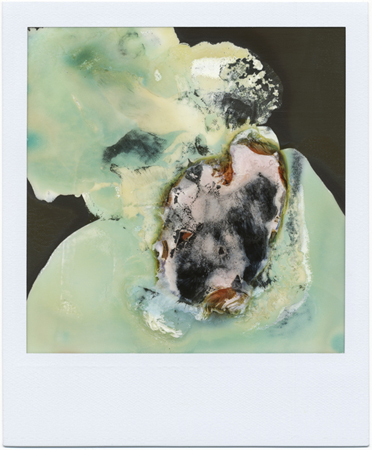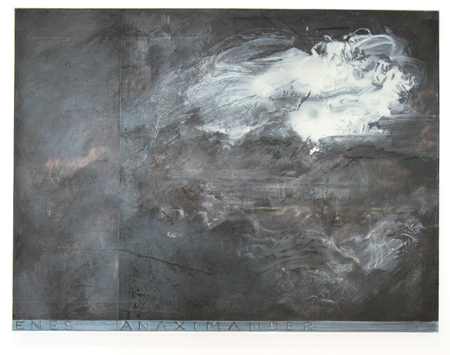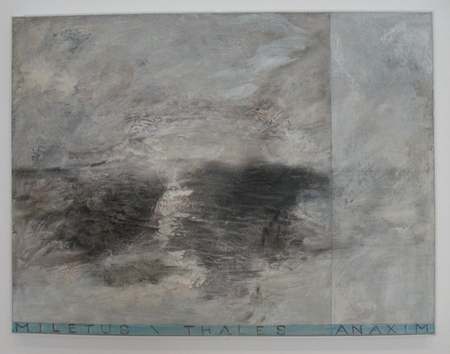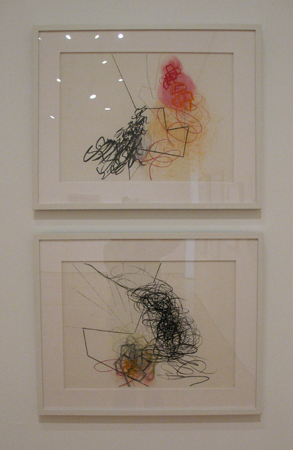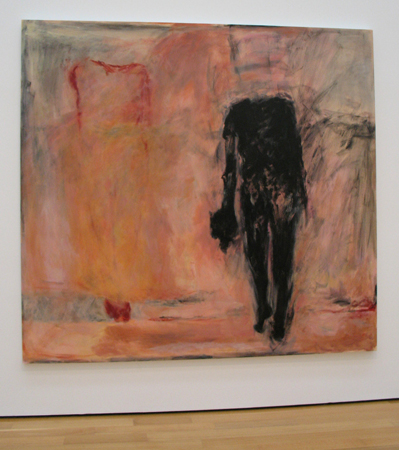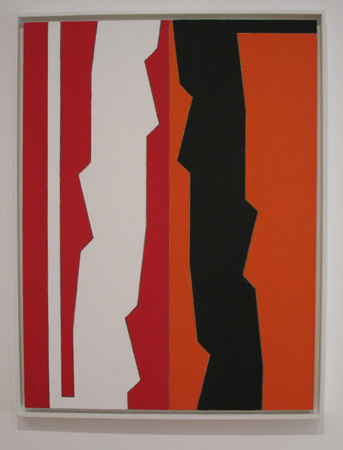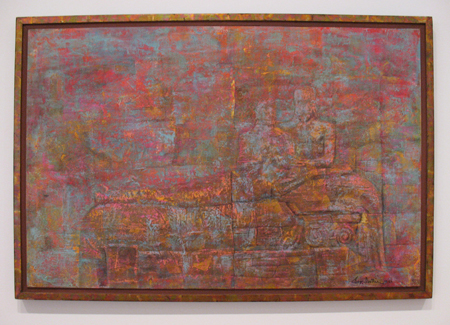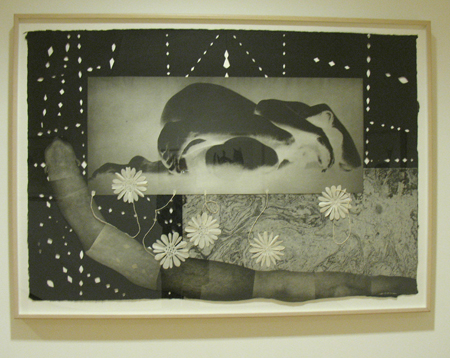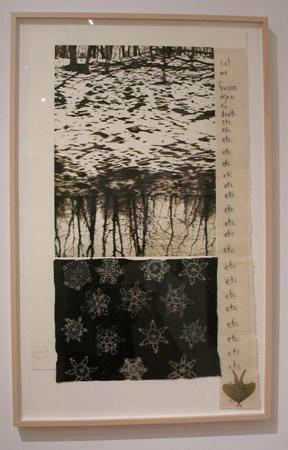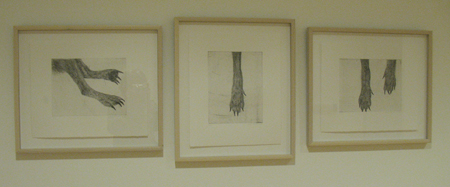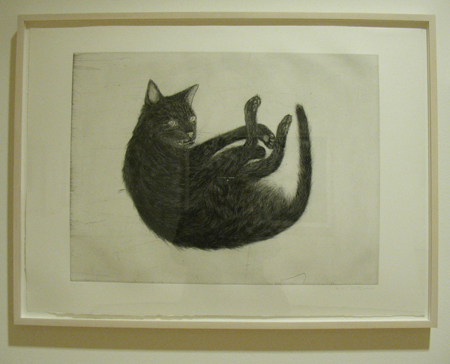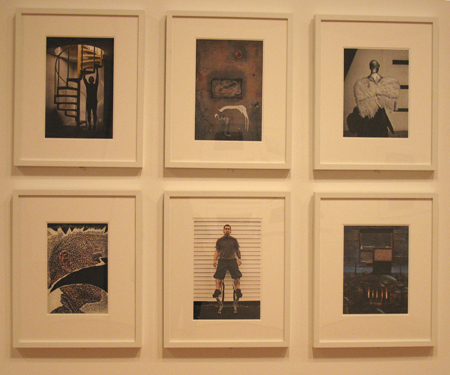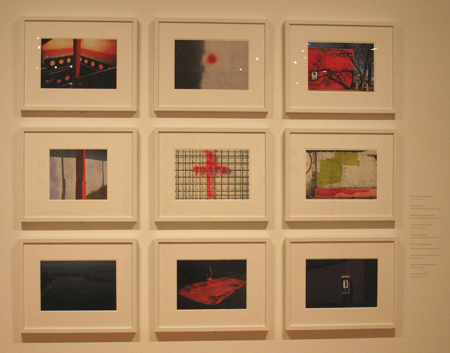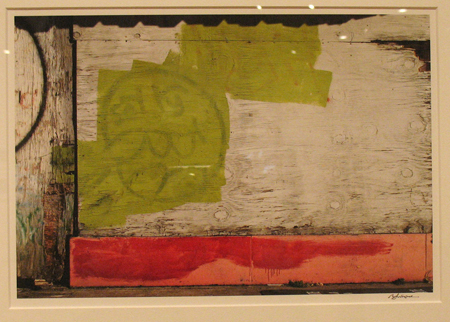Continuing my goal to hit most of the new gallery spaces in town within my first year of being back in Atlanta, I visited Poem88 off Howell Mill road yesterday for an artist’s talk by Ryan Nabulsi. Nabulsi is a young photographer working with old technology, as the gallery blurb notes:
“…Ryan Nabulsi’s camera-less photographs represent a natural conclusion to the goals of Steiglitz and Steichen in promoting pictorial photography. Relying on the manipulation of the photographic chemical process for instant photography, Nabulsi generates abstractions of lush color perhaps more akin to color field painting.”
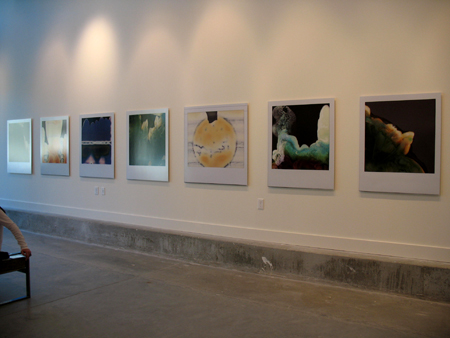
The artist is using film made for the old Kodak instant camera SX-70 but is not shooting with it. Instead, he’s manipulating the chemicals within the ‘pack film’ to create these images. In his artist statement he says:
“The work uses a familiar form of vernacular photography from the past, the SX-70 Polaroid, an instant analog film, and abstracts the chemistry using a variety of camera-less techniques. In addition, enlarging the images to ten times the instant film’s normal size, the familiar encounter with the SX-70 is taken out of context and brought into a different view.  These transformations explore the materiality of photography, the literal ‘insides of the medium.’  The contained pod of chemistry in the instant analog film is detached from its implied representational potential and given a new life that embodies the intersection of art and science.”  Â
Two large photos below courtesy of the artist.
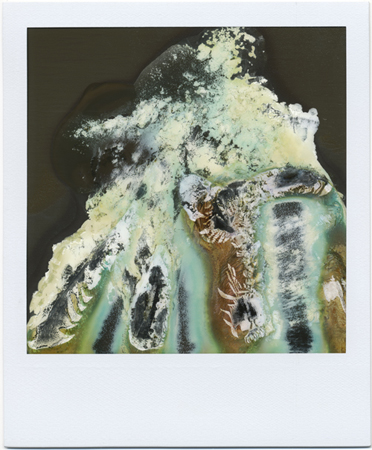
A photographer friend of mine conducted similar experiments with this early polaroid technology back in the mid 1980’s, except that he would shoot and then manipulate the ‘print’ during the brief development period of maybe 3 minutes. I still have some of those fabulous abstractions….
Next stop was a few blocks away at the High Museum of Art for “Trading Places, Part 1: Selected works from the Collection of MOCA GA”. This show of about 40 paintings and drawings by Georgia artists, runs until Feb. 5th.
Pyramid Scheme, ca. 1973, mixed media on paper. James Herbert. American, born 1938.
Miletus: Thales, Anaximenes, Anaximander, 1990, mixed media on canvas. Genevieve Arnold. American, 1928-2005.
Arnold refers to the ancient Greek city of Miletus in these paintings, the birthplace of modern philosophy and the three scholars cited in her works above. Installed together, the paintings create three equal squares, representing the three scholars of Miletus.
February 9, ’09 no. 1, 2009 and February 11, ’09 no. 1, 2009. Pastel, oil pastel and pencil on paper. Rocio Rodriguez. American, born Cuba 1952.
Schism, 1990, Oil on canvas. Rocio Rodriguez. American, born Cuba 1952.
This painting by Rodriguez was quite large and reminded me of the great Bay Area figurative painter Nathan Oliveira’s work, who died last year.
Wall Spirits and Other Secrets: Believe 01.20.09, 2008. Mixed media. Larry Walker. American, born 1935.
Basic Masai – II, 1989-1990. Acrylic on canvas. W. Medford Johnston. American, born 1941.
Due Soli, 1960. Acrylic on panel. George Beattie. American, 1919-1997.
The painting above simply glowed. The oranges, pale cobalts and pinks looked almost like encaustic and the artist achieved a unique luminosity from acrylic paints – which at the time were not that ubiquitous.
Get With Red, 1962. Lacquer on Masonite. Howard Thomas. American, 1899-1971.
A very jazzy painting. (I mentioned that before knowing that Thomas used music as inspiration during painting – as I do)
I also visited the Huber Family collection now on display at the High; Embracing Elegance, but was chastised by security for taking photos. So none to show from that exhibit, up until November 27th.
The third show I saw at the museum was a recently acquired collection of 56 prints by the American artist Kiki Smith, including works made between 1991 and 2004. Feminist based, her work can be both charming and humorously disturbing. I especially enjoyed her reinterpretations of traditional fairytales. The writer Angela Carter used ‘latent content’ of the tales in her 1979 The Bloody Chamber, and like her Smith turns the tales into commentary on gender and social inequalities.
Although some may critique her drawing capabilities, she herself notes in this video that she made the ‘problem’ work for her. “Either you’re stopped by what hampers you or you’re not….you can have tremendous talent but it doesn’t mean that you care about it. Being an artist is sort of a weird combination of different things…of needing to do something.” Â
This New York Times review by Holland Cotter of her 2006 show at the Whitney sheds a more serious light on her objectives. More about her background can be found in another interview during the same year with Michael Kimmelman. The exhibit at the High Museum is up until January 22nd, 2012.
Worm, 1992. Photogravure, etching, aquatint, and collage.
Etc., Etc., 1999. Photogravure, collaged lithograph, and photolithograph.
Born, 2002. Color lithograph, 68 1/8 x 56 1/8 inches.
Jewel, 2004. Aquatint and etching: set of three prints.
Rapture, In a Field, Splendid, 2002. Aquatint, etching and drypoint; series of three prints.
Close-up of ‘Splendid’.
I did not get a title for this etching of a cat, who may be dead…
Finally, I’d been wanting to see Chip Simone’s exhibit “Resonant Image” at the High for months. It’s only up now until November 6th. Chip has been a local photographer for decades and studied with Harry Callahan. I’ve always appreciated his work. Some of these more recent photographs look like abstract paintings. He switched from film to digital technology in 2000.
Unfortunately, I didn’t get captions with any of these in my efforts to shoot quickly without being noticed…
Birdman, Atlanta, 2008



